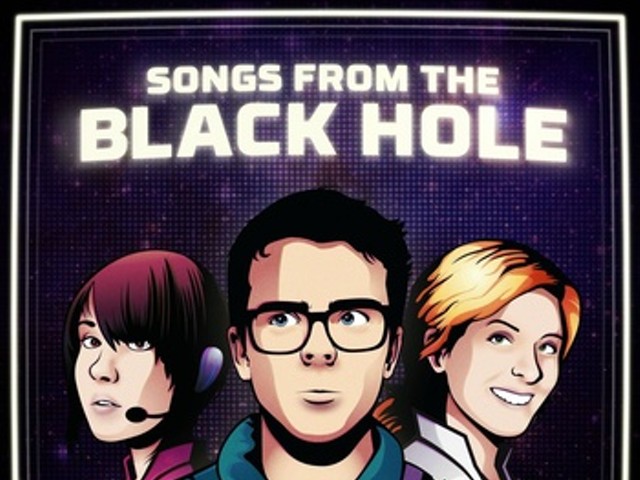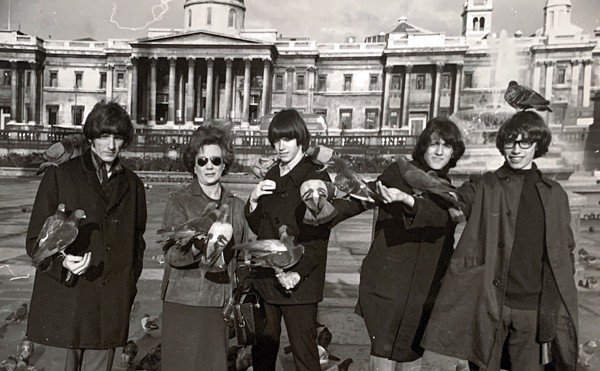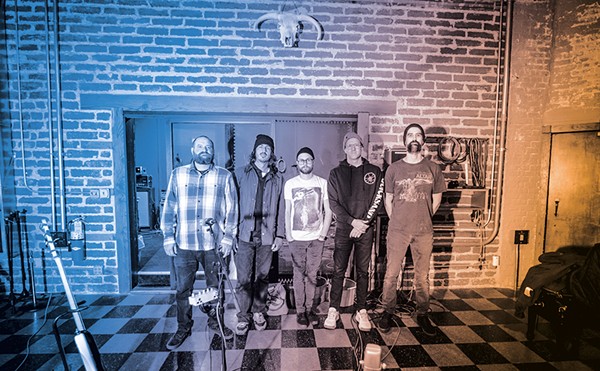Art and life co-habitate, informing, imitating, and enriching each other constantly. Each week in Better Living Through Music, RFT Music writer Ryan Wasoba explores this symbiotic relationship.
RFT's Daniel Hill wrote an article last week about Stlpunk, a localized proto-social networking site that helped musicians and fans connect to each other in surprisingly efficient ways. Stlpunk is one of the many trademarks of the St. Louis DIY music scene circa 2002-2006 whose significance is difficult to describe to those who were not involved (other examples: the Mega Rad Youth Crew, "Turtle Pole," and Adam the Devastator). One such strange, singular fixture of the time was the band Dancing Feet March To War.
See also: Remembering STLPunk.com -- How to View the Site Today and Find Your Old Profile Page
DFMTW was a spitfire noise punk band that formed around 2004. I saw most of its first shows, all of which were memorable for better or worse. Sometimes the band would put on a performance that made it seem like the only relevant group in the universe, and other times its shows were so attemptedly abstract that they were flat out embarrassing. The band appeared fearless at times, even though it was so caught up in ideology and concept that it was internally petrified of becoming part of some vague capitalist system if it achieved any amount of success.
DFMTW was the brainchild of bassist Stephen Inman (previously of streetpunk band Nineteen) and guitarist Robert Mayfield (formerly a member of adorable garage rock group The Reactions and later part of hardcore band Civic Progress). The band had a revolving door of drummers including perpetual band quitter Corey Smale, Clayton Kunstel of So Many Dynamos, Mic Boshans of The Floating City/Humdrum/Union Electric/Nee, and this one dirty hippie named Tyler.
The unofficial fourth member of the band was Lemp Arts Center owner Mark Sarich, who mentored the group. The phrase "Dancing Feet March To War" was even a Sarich quote. His involvement was obvious; he stood at the front rim of the crowd at every show and gave its members lengthy critiques afterwards. Much of his advice ate away at Inman and Mayfield from the inside, causing them to live so far inside of their own heads that what came out of their mouths and instruments was distorted or poorly translated. Some turn Sarich into a scapegoat for DFMTW's faults, but the band would not have even existed without his influence.
When DFMTW succeeded, its shows were legendary. Inman turned his confrontational frontman persona into performance art, and he sometimes ended shows by lulling the audience into sitting cross legged on the ground while he led a quiet singalong. Mayfield was more insular, and he had a way of convulsing that made me worry he was going to pull a muscle and made him lose about thirty pounds by the time the band ended. The band's songs were miniature collages that dangled brief nuggets of dance-punk and rallying chants in front of its listeners and then devolved into free-floating noise within seconds. This was the band's way of avoiding any chance of being associated with pop music, although the technique was reminiscent of the fadeout, a psychological tool of pop records that teases people with a song to make them want to hear it again.
The group recorded its initial run of jarring, patchwork songs on a CD titled Movement. It was released on Aim & Fire Records, a short lived label run by me, Clayton Kunstel, and Griffin Kay back when we were all in So Many Dynamos. I had personal and monetary investment in DFMTW, neither of which panned out well. Everything that made the band exciting - its headstrong aesthetic, its defiant approach to already defiant genres - also made it unsustainable from both a creative and business standpoint. The band was never in it to make a buck, but you can't run a van on cred.
Locally, the band played exclusively at the Lemp Arts Center with one exception. DFMTW landed an opening spot for Q and Not U at the Creepy Crawl. I was jealous; Q and Not U was one of my favorite bands at the time, and the group personally picked DFMTW over Dynamos for the slot. I've never before or since seen a band throw away an opportunity so carelessly. The group actually promoted against the show (Mirah played Lemp that same night, and Dancing Feet encouraged people to go there rather than spent the whopping $10 for Q and Not U). Its set was profoundly awkward. Freaked out by being on a stage, Inman spent the first half of the show in the audience. When that did not engage the crowd, he brought members on the stage to level the playing field. This made the band impossible to see. There were enough emotional walls put up between DFMTW and its audience -- we didn't need a physical one also.
If my tone is overall negative, it's because I cared so deeply about DFMTW. It is always frustrating to see potential fizzle out, but it was especially disheartening in this case. The band was determined to break down that boundary between audience and performer, but its members were never was able to put themselves in the crowd's place and play in a way that would satisfy the listeners as much as it satisfied themselves (or their overstepping life coach).
There's a lesson to learn from DFMTW and, like the band itself, it is rife with conflict. It's a lesson about what not to do, but also one about the pitfalls of being dominated by a hyper awareness about what not to do. It's a lesson about stepping out of comfort zones, even if your comfort zone is uncomfortable to everyone but yourself. Most of all, it's a lesson about choosing your battles. Even Fugazi plays on stages and understands you have to sell some records now and again. There's DIY or die, but there's also being so DIY that you're already dead.
Dancing Feet March To War existed in a pre-You Tube era, but one video exists of a show at Lemp during its final incarnation. It captures its aesthetic quite well - loud, disorganized, uncomfortable, and kind of fun. The crowd is small, but it's a Where's Waldo? book of today's noise scene fixtures. I spy a Ghost Ice, a Spelling Bee, and a member of the Lonely Procession, all artists who were undoubtedly informed by Dancing Feet March To War, the little engine that might have been if it only thought it could.






